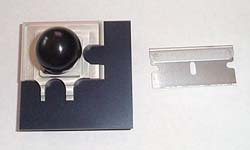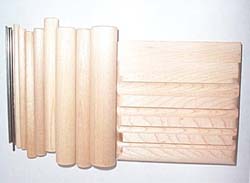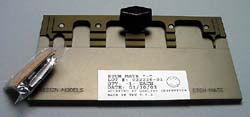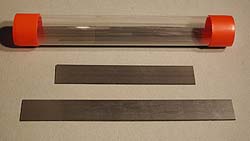Comparison between ..... The Small Shop's Hold & Fold
And Mission Models' Etch Mate
PE Folding tools By Ray Mehlberger If you have ever been frustrated, like I have been, in the past about bending and folding PE parts, two companies have come to our rescue. I will begin first with The Small Shop. They were the first ones to come out with a PE folding tool. I got a sample of their 4² unit, several years ago, and it was reviewed in the magazine at that time. Recently, The Small Shop approached me and told me that this tool had been completely redoneand would I like to review it and compare it to the first tool. I expected to get just the new 4² tool in the mail. Instead, I was flabbergasted to have received their whole product line. When The Small Shop contacted me, they told me they had a competitor. A newer company, Mission Models, had released a folding tool also. The Small Shop suggested that I might contact this new company and see if they wanted their tool compared and reviewed. I contacted them and they sent me their tool. More about this later.  The first Hold & Fold machine I received was all bright bare aluminum alloy with a round black knob. It came with a utility knife blade, which is used to lever the PE parts and bend them. This machine has always done a great job of bending PE parts into complex and simple shapes for me. Previously, I frustrated myself with a steel straight edged ruler and pliers. The first Hold & Fold machine I received was all bright bare aluminum alloy with a round black knob. It came with a utility knife blade, which is used to lever the PE parts and bend them. This machine has always done a great job of bending PE parts into complex and simple shapes for me. Previously, I frustrated myself with a steel straight edged ruler and pliers. The first thing that is noticable about the new 4² tool is that it no longer has the bright bare aluminum base plate. This is now anodized black color, which makes PE parts laid on it stand out vividly in contrast. The ball shaped knob is now a flatter knob with a ribbed edge. The base plate is also undercut, whereas the original was a straight 90 degree shot. There are three different top plates available for the 4² unit that I have seen pictured on The Small Shopıs web site. I received the one with the extra reach long holding fingers. I also noticed that this new toolıs base plate is a lot smoother milled than the original tool. The original one had some prominent swirls milled into the face of it, but this did did not deter from how it performed at all. I also found some burrs on the edges of the fingers on the original tool, which I got rid of with the aid of my needle files.  Although the new toolıs head is a lot smoother, there were still a burr or two. No problem, I will fix it with the needle files again. The utility knife blade has been replaced with a singe-edged razor blade in the new tool. There is also a second set of holes in the top plate to thread the guide pins into, when you reverse the head to use the longer folding edge. This tool sells for $45.00. Perhaps a little steep, but this tool will last you a lifetime. Although the new toolıs head is a lot smoother, there were still a burr or two. No problem, I will fix it with the needle files again. The utility knife blade has been replaced with a singe-edged razor blade in the new tool. There is also a second set of holes in the top plate to thread the guide pins into, when you reverse the head to use the longer folding edge. This tool sells for $45.00. Perhaps a little steep, but this tool will last you a lifetime. The new tool came in a sturdy, generic white box. It was in a cello bag in several pieces, with a instruction sheet. Parts breakdown was: the base-plate and top plate (held together by the two guide pins), a threaded short shaft, a coil spring, a black knob, the single-edged razor blade, and four self-adhesive vinyl pads to stick on the bottom of the base place to keep it from moving across the work bench when in use. The edges of the fingers are bevelled, on top, more than the original tool. Before you can use the new tool you have to do some minor assembly of the parts. First, you slide the top plate off the two guide pins. Next, you screw the short threaded shaft into the center hole in the base plate (The Small Shop suggests that you put a drop of CA in that hole first), The coil spring is now placed, loose, over the threaded shaft and the top plate re-seated onto the guide pins. Finally, you thread the black knob onto the threads of the short shaft that are above the top plate. I took a few pieces of PE and flolded them using both the old and new 4² tools. Both tools work the same way. The knob is loosend to raise the top plate slightly. The PE part is inserted underneath one of the fingers. The knife blade or single-edged razor blade is inserted under the part and levered upwards to bend the part into the final shapes needed. Simple as pie and it beats the tweezers and straight edge frustrations for sure.  Now, what of the other products that Small Shop sent me for review? The first of these is their 2² folding tool. Its design is the same as the 4² tool. The only noticable differences, between it and the new 4² tool, are that it has the round knob that is the same as what came on the first generation 4² tool. It also has fewer fingers on the top plate (only four) and has some burrs. The head can also be turned to accept longer pieces of PE. It came with the single-edged razor blade and needed minor assembly, the same as the 4² tool. This tool will be okay for 1/72nd scale PE sets, but not useful for long stretchs like 1/35th scale tank fenders or stretches of ship railings. You will have to opt for the bigger Hold & Fold tools. This little one sells for $30.00. Now, what of the other products that Small Shop sent me for review? The first of these is their 2² folding tool. Its design is the same as the 4² tool. The only noticable differences, between it and the new 4² tool, are that it has the round knob that is the same as what came on the first generation 4² tool. It also has fewer fingers on the top plate (only four) and has some burrs. The head can also be turned to accept longer pieces of PE. It came with the single-edged razor blade and needed minor assembly, the same as the 4² tool. This tool will be okay for 1/72nd scale PE sets, but not useful for long stretchs like 1/35th scale tank fenders or stretches of ship railings. You will have to opt for the bigger Hold & Fold tools. This little one sells for $30.00.  The third folding tool is 8² long. Obviously used for larger and longer PE parts. It is the same as the new 2² and 4² tools. The only difference is that it now has two black knobs. These are the same flat topped ones with the ribbed edges, like on the new 4" unit. It came with both felt and vinyl self-adhesive pads, to put on the bottom of it, to stop it skidding around. I donıt know if this is a use one or the other or both situation? This large unit has prominent swirls milled into the face of the black bottom plate. Very similar to what was on the first generation 4" folding tool, mentioned earlier. I donıt know if this will be a detriment to the toolıs performance or not? I doubt it. This tool also came partially disassembled, like the other new folding tools. I could find no burrs, this time, on this one. The price of this one is $70.00. The third folding tool is 8² long. Obviously used for larger and longer PE parts. It is the same as the new 2² and 4² tools. The only difference is that it now has two black knobs. These are the same flat topped ones with the ribbed edges, like on the new 4" unit. It came with both felt and vinyl self-adhesive pads, to put on the bottom of it, to stop it skidding around. I donıt know if this is a use one or the other or both situation? This large unit has prominent swirls milled into the face of the black bottom plate. Very similar to what was on the first generation 4" folding tool, mentioned earlier. I donıt know if this will be a detriment to the toolıs performance or not? I doubt it. This tool also came partially disassembled, like the other new folding tools. I could find no burrs, this time, on this one. The price of this one is $70.00.  In conjunction with the Hold & Fold units, I received the long folding blades. These are used vs the single-edged razor blades when using the long straight edge of the tools on long PE parts. One is 4² x 12² with a razor sharp edge down one side of its length, and the other one is 8² x 34² with the same razor edge. The 4² oneıs price is $3.50 and the 8² one is $5.00. In conjunction with the Hold & Fold units, I received the long folding blades. These are used vs the single-edged razor blades when using the long straight edge of the tools on long PE parts. One is 4² x 12² with a razor sharp edge down one side of its length, and the other one is 8² x 34² with the same razor edge. The 4² oneıs price is $3.50 and the 8² one is $5.00.  The next product, received for review, is The Small Shopıs PE part rolling set. It consists of a wood base, 3 12 ³ square, that has four round-bottomed channels machined into it on one side and a single one on the reverse side. There are also two stair-steps machined into the edge of the side with the four channels. You get eight round wooden dowels. These are all 4² long and graduate down in size from 34² to 3/16². However, there are only channels to fit the dowels that are 3/8² on down. I thought there should also be channels to accept the three larger dowels, the 12², 5/8², and 34² ones. There are also included four round steel rods. These all vary in length, but are all close to 4² long. These graduate down from 1/8² to 1/16² and have no corresponding channels in the wood base. The next product, received for review, is The Small Shopıs PE part rolling set. It consists of a wood base, 3 12 ³ square, that has four round-bottomed channels machined into it on one side and a single one on the reverse side. There are also two stair-steps machined into the edge of the side with the four channels. You get eight round wooden dowels. These are all 4² long and graduate down in size from 34² to 3/16². However, there are only channels to fit the dowels that are 3/8² on down. I thought there should also be channels to accept the three larger dowels, the 12², 5/8², and 34² ones. There are also included four round steel rods. These all vary in length, but are all close to 4² long. These graduate down from 1/8² to 1/16² and have no corresponding channels in the wood base. The way this tool is used is to place a PE part, that has to wind up being curved or cylindrical. On top of one of the channels and then roll the corresponding dowel on top of it. You should hold the PE part over a flame, until it glows red hot. Then let it cool at room temperature (donıt dip it into water). This will aneal it and make it easier to bend. I used this tool on one of my barrel rifling PE sets and it worked good. This tool is $8.00. very reasonable. I am told by Hold & Fold that the wood base is to be discontinued and replaced with an acrylic one.  Last, but not least, The Small Shop sent me their PE part cut off kit. This consists of three 4² x 4² black acrylic tiles and two clear acrylic pieces, that glue together, to make the ³press² handle. One of the clear acrylic pieces has one edge beveled and is the base of the press. The other clear piece is a round rod. It is super-glued onto the base plate to use as a handle. The Small Shop says that this handle may be one of several shapes in the set. The tiles come with paper backing on both sides. You remove the backing, on one side, on each of the tiles. Leave the paper on the backs of the tiles until they become worn, on the peeled side, then reverse sides. Last, but not least, The Small Shop sent me their PE part cut off kit. This consists of three 4² x 4² black acrylic tiles and two clear acrylic pieces, that glue together, to make the ³press² handle. One of the clear acrylic pieces has one edge beveled and is the base of the press. The other clear piece is a round rod. It is super-glued onto the base plate to use as a handle. The Small Shop says that this handle may be one of several shapes in the set. The tiles come with paper backing on both sides. You remove the backing, on one side, on each of the tiles. Leave the paper on the backs of the tiles until they become worn, on the peeled side, then reverse sides. Place a PE fret on one of the tiles. Place the clear press over the part or parts you wish to remove. Use a X-Acto or scalpel to cut along the edge of the press to free the parts. I use a X-Acto no. 10 blade, with its curved edge. Use a gentle rocking pressure, rather than slicing motion. Lift the fret to leave the parts on the tile. Move these to the second tile for sanding the nubs off. After sanding, move the parts to the third tile. The black color of the tiles gives good contrast to both brass and steel colored PE. The hard acrylic does not let the blade skip or break, but is firm enough to not deform parts. Previously, I used a piece of plate glass to cut my PE parts on. It worked well, but you could skid on it if not careful. This last item from The Small Shop sells for $9.50, again very reasonable. Hold & Fold recently took on a new partner called Kalama Precision Machine. They are doing the machining on the new units. I recommend all these sets. My only reservation is the burrs I found on some of the fingers of the Hold & Fold units. These need to be tumbled in a drum with sanding powder to remove these small burrs. However, I easily removed them with my needle files. I want to thank Pete Forest of the Small Shop for these generous samples. The Small Shop can be reached at: ORDERING USA
The Small Shop USA
C/O Kalama Precision Machine
PO Box 580
Kalama, WA 98625
USA Phone 360-673-1255 ext. 11
24 Hr Fax 360-673-1255
Sales@thesmallshop.com The Small Shop has a competitor. This company is called Mission Models. They too make a PE folding tool, called The Etch Mate. Pete Forest, owner of The Small Shop, asked me to contact them and see if they wanted their tool reviewed and compared to his. I did so and Jon Tamkin, of Mission Models, sent me their tool.  The tool came in a sturdy, generic white box. It was in a encapsulated bubbles bag with a single-edged razor blade and four black vinyl self-adhesive pads to put on the bottom to stop it traveling across the work bench when in use. It came fully assembled. This folding tool is made from olive drab colored anodized aluminum alloy. The top plate is olive drab like the base plate. It has a black diamond shaped knob. This unit is 6 12² x 3 12² in size. The front edge of the base plate has "Mission Models" and "Etch Mate" engraved into it. The top plate has six different widths of holding fingers and can be reversed to use the long straight edge for larger PE parts. It has four guide pins that the top plate rides on. The toolıs base is Blanchard ground using space age machining. The whole unit is very smooth. The tool came in a sturdy, generic white box. It was in a encapsulated bubbles bag with a single-edged razor blade and four black vinyl self-adhesive pads to put on the bottom to stop it traveling across the work bench when in use. It came fully assembled. This folding tool is made from olive drab colored anodized aluminum alloy. The top plate is olive drab like the base plate. It has a black diamond shaped knob. This unit is 6 12² x 3 12² in size. The front edge of the base plate has "Mission Models" and "Etch Mate" engraved into it. The top plate has six different widths of holding fingers and can be reversed to use the long straight edge for larger PE parts. It has four guide pins that the top plate rides on. The toolıs base is Blanchard ground using space age machining. The whole unit is very smooth. There is a slot in the base plate that is a folding channel and allows for very straight bends. When you fold PE 90 degrees your razor blade will bottom out into this channel. I tried this and it works well.  Both the folding head and base are matched sets. Each folding head is put through a hand leveling process, which allows the folding head to sit flat against the base, resulting in superior clamping strength. Mission says that this means less force needed whn tightening the PE into the Etch Mate. The extra guide pins eliminate play between the tool head and base. The tool sells for $65.00. It came with a set of long folding blades. These are double beveled on one edge and similar to the ones that I got from The Small Shop. They came in a protective clear tube. One is 6 12" x 34" and the second one is 4 12" x 34". They have razor sharp edges, so you could easily cut yourself on them. However, they are thinner and more flexible than the ones from The Small Shop. These long blades sell for $7.00 per pair. They are great for PE pieces, such as fenders, railings, side skirts, and structure parts. Both the folding head and base are matched sets. Each folding head is put through a hand leveling process, which allows the folding head to sit flat against the base, resulting in superior clamping strength. Mission says that this means less force needed whn tightening the PE into the Etch Mate. The extra guide pins eliminate play between the tool head and base. The tool sells for $65.00. It came with a set of long folding blades. These are double beveled on one edge and similar to the ones that I got from The Small Shop. They came in a protective clear tube. One is 6 12" x 34" and the second one is 4 12" x 34". They have razor sharp edges, so you could easily cut yourself on them. However, they are thinner and more flexible than the ones from The Small Shop. These long blades sell for $7.00 per pair. They are great for PE pieces, such as fenders, railings, side skirts, and structure parts. I recommend any one of these folding tools. I found the Etch Mate to be smoother surfaced than the Hold & Fold units, and the positioning slot in the base is useful. Otherwise, I felt that they all performed well. I want to thank Jon Tamkin of Mission Models for the geneorous samples. Mission Models also sells armor kits and accessories. They can be reached at: Mission Models
3408 Glendale Blvd.
Los Angeles, CA 90039
USA Phone: 323-666-4228 | 








|